Introduction (click photos for larger vew, turn off Popup Blockers))
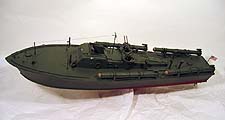 My love affair with PT Boats began back when I was in middle school when I built my first of several Lindberg PT 109 kits. When I was 14 years old I made my first venture into scratchbuilding when I began work on a 1/32nd scale model of Lt. John D. Bulkeley’s famous PT 41, the boat which General MacArthur rode during his famous escape from Corregidor en route to Australia in March of 1942. I never completed the model but the 77’ Elco boats have held a fond place in my heart. Fast forward almost two decades to late 2006 when the opportunity arose for me to finally build one of “The Expendables” from scratch. Frank J. Andruss, Sr. contacted me and asked if I would build a model of the 41 Boat for his Mosquito Fleet Exhibit which would be opening soon in Springfield, MA. I would argue that PT 41 is the most historically significant single PT Boat of World War II and I jumped at the opportunity to make a model which would be seen by the public in a museum. Frank contracted me to build the model in 1/24th scale as a component to his display on RON 3 and the early Philippine campaign. Armed with Al Ross II’ detailed plans of PT 34, I began research on exactly how the boat appeared during the MacArthur breakout mission. After the outbreak of hostilities in December of 1941, the RON 3 boats were painted an overall green using locally procured paint, the plexiglass domes on the Dewandre power turrets were removed and the guns were converted to manual operation. A photograph from Mark Culp, who’s grandfather served aboard PT 31, proved particularly useful illustrating the exact configuration of the radio antenna and other minor details. My love affair with PT Boats began back when I was in middle school when I built my first of several Lindberg PT 109 kits. When I was 14 years old I made my first venture into scratchbuilding when I began work on a 1/32nd scale model of Lt. John D. Bulkeley’s famous PT 41, the boat which General MacArthur rode during his famous escape from Corregidor en route to Australia in March of 1942. I never completed the model but the 77’ Elco boats have held a fond place in my heart. Fast forward almost two decades to late 2006 when the opportunity arose for me to finally build one of “The Expendables” from scratch. Frank J. Andruss, Sr. contacted me and asked if I would build a model of the 41 Boat for his Mosquito Fleet Exhibit which would be opening soon in Springfield, MA. I would argue that PT 41 is the most historically significant single PT Boat of World War II and I jumped at the opportunity to make a model which would be seen by the public in a museum. Frank contracted me to build the model in 1/24th scale as a component to his display on RON 3 and the early Philippine campaign. Armed with Al Ross II’ detailed plans of PT 34, I began research on exactly how the boat appeared during the MacArthur breakout mission. After the outbreak of hostilities in December of 1941, the RON 3 boats were painted an overall green using locally procured paint, the plexiglass domes on the Dewandre power turrets were removed and the guns were converted to manual operation. A photograph from Mark Culp, who’s grandfather served aboard PT 31, proved particularly useful illustrating the exact configuration of the radio antenna and other minor details.
Hull, Deck and Superstructure
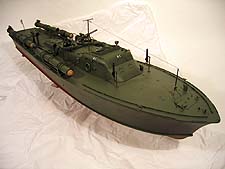 In the interest of economy and being able to complete the model in time for the opening of The Mosquito Fleet Exhibit, I elected to purchase a manufactured hull from Wayne Enterprises. Wayne Traxel offers an excellent fiberglass 77’ Elco hull and cabin package for both early and later series 77’ Elco. My order arrived at my doorstep and I was thoroughly impressed with the impeccable fiberglass work as well as the hull’s strength and accurate shape. It includes molded gunwales and is remarkably light. At 38” long, this would be excellent for any radio controlled model. The cabin even includes the engine room hatch. In the interest of economy and being able to complete the model in time for the opening of The Mosquito Fleet Exhibit, I elected to purchase a manufactured hull from Wayne Enterprises. Wayne Traxel offers an excellent fiberglass 77’ Elco hull and cabin package for both early and later series 77’ Elco. My order arrived at my doorstep and I was thoroughly impressed with the impeccable fiberglass work as well as the hull’s strength and accurate shape. It includes molded gunwales and is remarkably light. At 38” long, this would be excellent for any radio controlled model. The cabin even includes the engine room hatch.
I admired the workmanship some more and then went to work. The deck beams were made with laminated 1/16” balsawood and attached to the gunwales with epoxy. Unlike the 78’ Higgins or 80’ Elco models which had relatively flat decks, the 70’ and 77’ Elco boats had a distinct hump and camber which can be tricky when making models. Satisfied with the layout, I covered the framework with a layer of balsa and layer of basswood. After numerous coats of Bondo followed by sanding and polyurethane varnish, the deck was smooth and I attached the spruce toe rails. Before beginning work topsides, I turned the hull over and drilled all the guide holes for the propeller shafts, struts and rudders. I reasoned that if I tried to do this later, it might prove difficult and I might damage the details above deck. At this time I also added the spruce chine bands and fabricated the transom details. Unlike the second-series 77’ boats and the 80’ers, the 70’ and early 77’ Elco boats did not have mufflers. I made the exhaust pipes from aluminum rivets and used brass tubing for the cooling water outlets as well as the overflows on the side of hull.
The two major structural building tasks on the 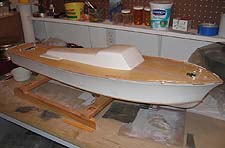 cabin were the gun turrets and the cockpit. I carefully cut out sections from the fiberglass cabin and fitted the turrets which were made of plastic rocket tube. The sloping cabin proved a challenge to fair in the turrets. I built the locker between the turrets using sheet styrene and included a block of wood which later held the depression rail. The cockpit walls and floor were made using sheet styrene and I used thin plastic to make the charthouse door and the window above the helm. An interesting side note is that the original Elco boats were patterned after the English design of duplicate controls on the bridge and in the pilothouse. The cockpit floor was made with plastic strips to simulate grating. cabin were the gun turrets and the cockpit. I carefully cut out sections from the fiberglass cabin and fitted the turrets which were made of plastic rocket tube. The sloping cabin proved a challenge to fair in the turrets. I built the locker between the turrets using sheet styrene and included a block of wood which later held the depression rail. The cockpit walls and floor were made using sheet styrene and I used thin plastic to make the charthouse door and the window above the helm. An interesting side note is that the original Elco boats were patterned after the English design of duplicate controls on the bridge and in the pilothouse. The cockpit floor was made with plastic strips to simulate grating.
Main Details
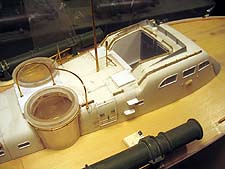 With the major structural work done, I turned to the many superstructure details on the model PT 41. First, I made the boot on the front of the cabin using a balsa framework covered with thin sheet plastic. Time consuming were the cabin windows which were cut into the fiberglass cabin and framed out with plastic strips. I learned that the windows on the RON 3 boats were painted over and this made my job easier since I would not have to worry about showing the interior of the boat. The extensive array of grab rails was fabricated with brass rod and eyelets. I used solid brass washers for the front window wipers. Next were the steps up into the cockpit, the deck windows over the engine room hatch and the fishtail plates which connected the three cabin sections which I made with photo-etched brass. I used a teardrop-shaped brass tube for the telescopic mast which would later receive the radio antenna. Completing the cockpit area included the bell, throttle quadrant, switch panel, and windscreen. John R. Haynes generously donated a number of parts for use in the model PT 41 for Frank’s Mosquito Fleet Exhibit including the cast metal helm. John’s fittings are excellent and I am grateful for the opportunity to use his fine products. With the major structural work done, I turned to the many superstructure details on the model PT 41. First, I made the boot on the front of the cabin using a balsa framework covered with thin sheet plastic. Time consuming were the cabin windows which were cut into the fiberglass cabin and framed out with plastic strips. I learned that the windows on the RON 3 boats were painted over and this made my job easier since I would not have to worry about showing the interior of the boat. The extensive array of grab rails was fabricated with brass rod and eyelets. I used solid brass washers for the front window wipers. Next were the steps up into the cockpit, the deck windows over the engine room hatch and the fishtail plates which connected the three cabin sections which I made with photo-etched brass. I used a teardrop-shaped brass tube for the telescopic mast which would later receive the radio antenna. Completing the cockpit area included the bell, throttle quadrant, switch panel, and windscreen. John R. Haynes generously donated a number of parts for use in the model PT 41 for Frank’s Mosquito Fleet Exhibit including the cast metal helm. John’s fittings are excellent and I am grateful for the opportunity to use his fine products.
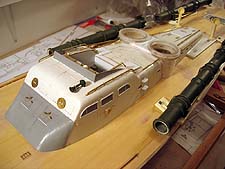
With the superstructure completed, I turned to the deck and the many topside fittings. Hatches were made with wood and I superdetailed them with wire latches. The deadlight frames were photo-etched from brass and I was pleased with the crisp look it gives to an otherwise-uncluttered deck. The 41 Boat model was quite a departure from my other projects depicting later-war boats where the decks are typically covered with guns, ammunition boxes and rocket launchers. Chocks and cleats came from my spare parts box. The tall ventilators and Elco bollards were made of cast resin.
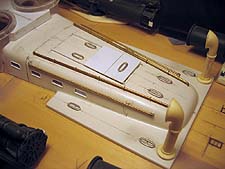 Below the waterline, the running hardware was made from metal and cast resin parts. I fabricated the struts with streamline aluminum stock and plastic tube. Propeller shafts were made of brass tubing and the rudders were shaped from surplus Higgins rudders. The superior maneuverability of the 78’ Higgins compared with the 80’ Elco boats was undoubtedly due in part to the large Higgins rudders. Making the tiny rudders for the 41 Boat was a simple matter of cutting the relatively huge Higgins rudders down to the correct size. Below the waterline, the running hardware was made from metal and cast resin parts. I fabricated the struts with streamline aluminum stock and plastic tube. Propeller shafts were made of brass tubing and the rudders were shaped from surplus Higgins rudders. The superior maneuverability of the 78’ Higgins compared with the 80’ Elco boats was undoubtedly due in part to the large Higgins rudders. Making the tiny rudders for the 41 Boat was a simple matter of cutting the relatively huge Higgins rudders down to the correct size.
Armament
The main punch of the early PT Boats was the torpedo armament. Like the other 77’ and early 80’ Elco boats designed to fulfill the torpedo boat role, PT 41 carried four 21” torpedoes in Mark 18 torpedo tubes. I salvaged a set of tubes from a project from about 15 years ago but gave them a thorough overhaul and refit. Besides cleaning them up, the tubes were given an upgrade with new training gear. At this point I added photo-etched wingnuts to the backs and removed the front tube covers. I wanted to make the boat armed as she would have been during the MacArthur breakout mission so I added Mark 8 warheads. They were made of resin with bronze powder added for a metallic look.
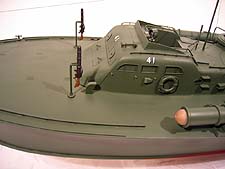 The early series of 77’ Elcos were built with twin .50 caliber machine guns in pneumatic / hydraulically operated Dewandre power turrets. Many were field-converted to manual operation after the outbreak of war. RON 3 boats were changed over within days of the Pearl Harbor attack and I have seen several photographs and motion picture footage showing a number of RON 1 boats around the Hawaiian Islands and at Midway with such configurations. It appears that the elevating cylinders were removed and the guns braced at a suitable angle with a pipe. I made the bases and mounts from plastic stock and various items from my scrap The early series of 77’ Elcos were built with twin .50 caliber machine guns in pneumatic / hydraulically operated Dewandre power turrets. Many were field-converted to manual operation after the outbreak of war. RON 3 boats were changed over within days of the Pearl Harbor attack and I have seen several photographs and motion picture footage showing a number of RON 1 boats around the Hawaiian Islands and at Midway with such configurations. It appears that the elevating cylinders were removed and the guns braced at a suitable angle with a pipe. I made the bases and mounts from plastic stock and various items from my scrap 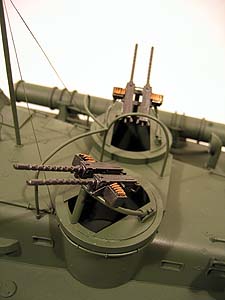 bin. The four .50 caliber Browning machine guns were another part of John R. Haynes’ generous donation to the project. They cleaned up beautifully and were mounted on the cradles. I added my own scratchbuilt ammunition boxes and finished the assembly by adding Haynes’ ammunition belts. At this point I was struck by the visibly small capacity of the ammunition boxes. Crews must have really had to be conservative when firing the guns in action. The guns and belts add greatly to the model since PT 41 was relatively lightly armed compared to the later-war “barge busters” so often seen in modeling subjects. bin. The four .50 caliber Browning machine guns were another part of John R. Haynes’ generous donation to the project. They cleaned up beautifully and were mounted on the cradles. I added my own scratchbuilt ammunition boxes and finished the assembly by adding Haynes’ ammunition belts. At this point I was struck by the visibly small capacity of the ammunition boxes. Crews must have really had to be conservative when firing the guns in action. The guns and belts add greatly to the model since PT 41 was relatively lightly armed compared to the later-war “barge busters” so often seen in modeling subjects.
Finally, the 41 Boat received two single .303 caliber Lewis guns on tripods just forward of the superstructure. The guns were cast from an old scratchbuilt pattern and mounted on brackets made of aircraft landing gear braces from my scrap bin. The stocks of the Lewis guns were painted a wood color and all the guns were airbrushed with Testors gunmetal.
Painting and Final Details
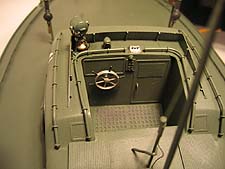 The rudders, struts and shafts were painted with Testors steel and bronze. The propellers were buffed and covered with Testors Dullcoat. I then flipped the boat over and proceeded to paint topsides. My research revealed that upon the outbreak of hostilities the RON 3 boats were painted an overall dark green. The locally procured paint was thinned with gasoline and swabbed on the hulls, decks and superstructure. I am indebted to Al Ross II for his insight and advice here. His father was PT 34’s quartermaster and was present for the camouflaging. I used Testors Olivgrun, actually a German color but very similar to a US Navy shade of green I have used on other PT Boat models. Modelers and historians could debate the exact shade of the RON 3 boats all day. I am satisfied with this color since it is fairly dark and covers the boat well. I applied the paint with my airbrush and later weathered certain parts of the boat with washes of thinned black paint. Areas which I dirtied and scuffed up included around the exhaust pipes on the transom, the deck area around the engine room hatch and area leading toward the cockpit, and the steps over the cabin and the cockpit floor. I hope I achieved the desired effect. Below the waterline was painted with Krylon red oxide primer. The rudders, struts and shafts were painted with Testors steel and bronze. The propellers were buffed and covered with Testors Dullcoat. I then flipped the boat over and proceeded to paint topsides. My research revealed that upon the outbreak of hostilities the RON 3 boats were painted an overall dark green. The locally procured paint was thinned with gasoline and swabbed on the hulls, decks and superstructure. I am indebted to Al Ross II for his insight and advice here. His father was PT 34’s quartermaster and was present for the camouflaging. I used Testors Olivgrun, actually a German color but very similar to a US Navy shade of green I have used on other PT Boat models. Modelers and historians could debate the exact shade of the RON 3 boats all day. I am satisfied with this color since it is fairly dark and covers the boat well. I applied the paint with my airbrush and later weathered certain parts of the boat with washes of thinned black paint. Areas which I dirtied and scuffed up included around the exhaust pipes on the transom, the deck area around the engine room hatch and area leading toward the cockpit, and the steps over the cabin and the cockpit floor. I hope I achieved the desired effect. Below the waterline was painted with Krylon red oxide primer.
The boat’s numbers were applied using decals 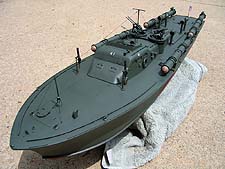 from a model airplane kit. They went on easily and were sealed with Dullcoat. The intricate radio antenna running from the mast to the foredeck took some patience and a steady hand but turned out fine in my estimation. Interestingly, I have seen several radio controlled models of RON 3 boats and typically the necessity of a removable center section on the deck to access the R/C gear precludes having the full antenna arrangement. This was a nice departure for me because unlike my own models which are 1/24th scale and radio controlled, the static PT 41 could be fully authentic. Mark Culp’s photograph was particularly useful here. Appropriately, the final step was mounting the 48 star flag on the fantail. from a model airplane kit. They went on easily and were sealed with Dullcoat. The intricate radio antenna running from the mast to the foredeck took some patience and a steady hand but turned out fine in my estimation. Interestingly, I have seen several radio controlled models of RON 3 boats and typically the necessity of a removable center section on the deck to access the R/C gear precludes having the full antenna arrangement. This was a nice departure for me because unlike my own models which are 1/24th scale and radio controlled, the static PT 41 could be fully authentic. Mark Culp’s photograph was particularly useful here. Appropriately, the final step was mounting the 48 star flag on the fantail.
Frank Andruss had the bright idea to mount the 41 Boat on an angled wooded display stand similar to the Elco models built during World War II. Elco had its own professional model builder named Don Rosencrantz on staff who made exquisite models, one of which can be seen in Frank’s Mosquito Fleet Exhibit. I fashioned the 41 Boat’s stand after Rosencrantz’s design using a teardrop-shaped piece of mahogany. This was a departure from my stands which are strictly functional for my radio controlled models. The boat was mounted to the case with two long bolts. The “less is more” approach to static model stands paid off and I am happy with the overall appearance of the boat. She looks almost weightless, like she is about to jump off the stand and over the next wave!
Conclusion
It was a pleasure to build the model of PT 41 for Frank Andruss’ Mosquito Fleet Exhibit currently on display in Springfield, MA. I delivered the boat to him and it went right into the case built by Stan Pienkowski. She sits proudly in the RON 3 section of the display surrounded by memorabilia and artifacts from Bulkeley and the other “Expendables.” Special thanks to those who contributed toward the 41 Boat project including Wayne Traxel for his fiberglass hull and cabin as well as many ideas and suggestions, John R. Haynes for donating the fittings and armament, Al Ross II for technical advice and Mark Culp for the PT 32 photograph. Finally, a sincere thanks to Frank Andruss for asking me about this project. I was finally able to complete my dream of scratch building the most historically significant individual PT Boat.
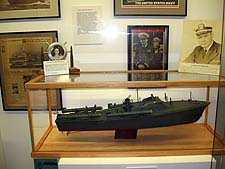
|